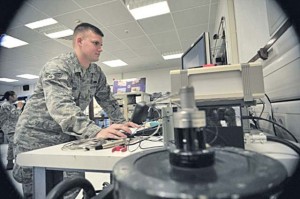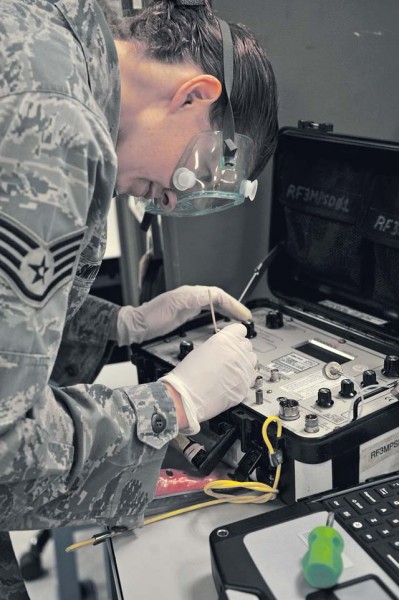Precision is a part of everyday life, whether an Airman realizes it or not, and the members of the 86th Maintenance Squadron Precision Measurement Equipment Laboratory ensure the accuracy of equipment used by several commands that operate in Europe, Africa and Asia.

Senior Airman Dustin Wood, 86th Maintenance Squadron Precision Measurement Equipment Laboratory technician, runs a vibration calibration on a velocity sensor July 30 on Ramstein.
As the largest PMEL in the Air Force, the shop supports more than 400 work centers under the U.S. Africa Command, U.S. Central Command, U.S. European Command and the U.S. Transportation Command by calibrating 14,000 items that require quantitative measurements.
“We deliver accurate equipment to the warfighter and support every major weapon system in the Air Force,” said Chief Master Sgt. Craig Niemann, 86th MXS PMEL flight chief.
PMEL does this by maintaining the precision of those 14,000 items to within one percent of the accepted standards. This ensures that Airmen using those items get the expected results when using them.
“For people that don’t know what we do, I always use the example of pumping gas,” Niemann said. “When you go to the gas pump, how do you know you are getting five gallons of gas? How do you know it’s not four?”
The laboratory is separated into three sections, with each one specializing in a specific focus of calibrations. The sections are named after the technical orders the PMEL technicians use to perform their calibrations.
The K1K8 section deals with alternating and direct current measurements. This section focuses more on the devices that actually perform the measurements on other devices, including those used by PMEL.
“When a civil engineer plugs in a multimeter to see if he turned off the power and looks at the voltage he gets out, he’s depending that when that meter says there is no voltage there actually isn’t any,” Niemann said.
The K3K4 section works more with instruments that measure vibrations and oscillations. Ramstein’s K3K4 section is one of only two shops in U.S. Air Forces in Europe that possesses a vibration calibration system. This system is used to ensure items like velocity sensors, which can aid maintenance Airmen in monitoring aircraft engines and pro-actively replacing parts, work properly.
Then there is the K5K6 section which handles the physical measurements such as temperature, pressure and weight. This section does approximately 70 percent of the work that the Ramstein PMEL handles. Some of the items they calibrate include load scales used to accurately measure cargo before it’s loaded onto aircraft. This section also houses one of two infrared target simulators in the Air Force. The IR target simulator helps attune the tracking of certain missiles.
“We support on- and off-base work centers,” said Senior Airman Steven Jara, 86th MXS PMEL technician. “We support nearly everything except medical, however, we do provide support for biomedical technicians.”
Depending on the item, calibration can take anywhere between 30 minutes to up to two weeks for larger, more complex systems; and, though PMEL’s job varies greatly, it is that aspect of their job that keeps them focused on the calibrations they are performing.
“Before I joined the Air Force and learned about the job, I honestly didn’t think anything about accuracies,” Jara said. “It’s something we don’t normally think about daily, but it’s critical for us when a small error can mean a lot of trouble for many.”

Photo by Senior Airman Timothy Moore
Staff Sgt. Amy Smith, 86th Maintenance Squadron Precision Measurement Equipment Laboratory technician, cleans the connectors on a fuel quantity test set July 30 on Ramstein. As the largest PMEL in the Air Force, the shop supports more than 400 work centers under the U.S. Africa Command, U.S. Central Command, U.S. European Command and the U.S. Transportation Command by calibrating 14,000 items that require quantitative measurements.


